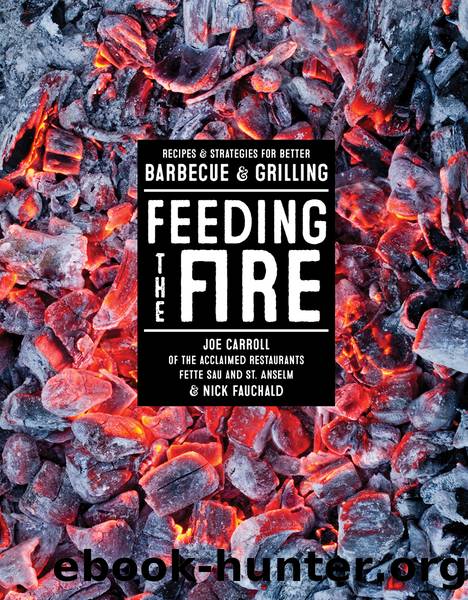Feeding the Fire by Joe Carroll

Author:Joe Carroll
Language: eng
Format: epub
Publisher: Artisan
Lesson no 10
Fire Equals Flavor
The secret to great grilling lies in the char, something only a hot grill can deliver. It can transform an ordinary piece of meat or fish into something deeply primal tasting, with a textural harmony that drives carnivores crazy: a crunchy, burnished crust and a juicy, tender interior.
Unfortunately, most cooks are afraid to give food the char it deserves. They equate char with burnt food, but the two are distinctly different: Burnt food is completely carbonized and tastes acrid and unpleasant. Char is deep caramelization on a food’s surface, that smoky-sweet flavor we associate with live-fire cooking; without it, you might as well stand at the stove.
People also get too hung up on creating perfect crosshatched grill marks on their meat. While this looks great in photographs, they’re missing out on a lot of surface area that could be charred; this is why I prefer to move and turn meat frequently while making sure that as much of its surface touches the hot grill grates as possible. A steak charred all over tastes significantly better than one with a few black stripes. And this flavor gets even better when you add charcoal to the equation, but I’m getting ahead of myself. First you need to pick a grill.
Choose Your Grill
Gas or charcoal? Choosing a grill begins with the all-important question of fuel. While you can make the recipes in this book using a gas grill, grill pan, or, hell, even a George Foreman “grill,” grilling without charcoal is like playing bluegrass without a banjo: something will be unmistakably absent. I’ve already emphasized the importance of using hardwood charcoal when barbecuing—there’s no substitute for the flavor it adds to smoked meat. The same goes for grilling. While it’s true that nothing can compete with the convenience of a gas grill, it’s also true that nothing can compete with the flavor of charcoal-grilled food.
Gas Grills
Gas grills can be lit with the push of a button and are ready to start cooking in a few minutes, and you never have to worry about tending a fire or adding more fuel (until the propane tank runs out). The cooking temperature is both more consistent and easier to adjust with gas, you can easily create two or more heat zones, and there is far less cleanup when you’re finished. Many gas grills also have neat accessories and add-ons, like side burners, warming racks, and rotisseries. For all of these reasons, most home cooks opt for gas grills.
However, gas grills lose out to charcoal in two important categories: First, most gas grills can’t get nearly as hot as even the cheapest charcoal grill, which means food won’t get enough char before it’s cooked through. A commercial gas grill can get as hot as charcoal, yes, but most of the four-wheeled contraptions sitting on our decks and patios don’t come close. More important, you’re missing out on a key ingredient when you cook with gas: charcoal. Carbonized wood is more than just
Download
This site does not store any files on its server. We only index and link to content provided by other sites. Please contact the content providers to delete copyright contents if any and email us, we'll remove relevant links or contents immediately.
| Cajun & Creole | California |
| Hawaiian | Mid-Atlantic |
| Midwestern | New England |
| Northwestern | Soul Food |
| Southern | Southwestern |
| Western |
Biscuits: A Savor the South Cookbook by Belinda Ellis(4276)
The French Women Don't Get Fat Cookbook by Mireille Guiliano(3580)
A Jewish Baker's Pastry Secrets: Recipes from a New York Baking Legend for Strudel, Stollen, Danishes, Puff Pastry, and More by George Greenstein(3529)
Better Homes and Gardens New Cookbook by Better Homes & Gardens(3508)
Ottolenghi Simple by Yotam Ottolenghi(3498)
Al Roker's Hassle-Free Holiday Cookbook by Al Roker(3486)
Trullo by Tim Siadatan(3365)
Bake with Anna Olson by Anna Olson(3342)
Hot Thai Kitchen by Pailin Chongchitnant(3304)
Panini by Carlo Middione(3234)
Nigella Bites (Nigella Collection) by Nigella Lawson(3159)
Momofuku by David Chang(3127)
Salt, Fat, Acid, Heat: Mastering the Elements of Good Cooking by Nosrat Samin(3094)
Modern French Pastry: Innovative Techniques, Tools and Design by Cheryl Wakerhauser(3060)
Best of Jane Grigson by Jane Grigson(2933)
Classic by Mary Berry(2929)
Tapas Revolution by Omar Allibhoy(2914)
Solo Food by Janneke Vreugdenhil(2912)
Ottolenghi - The Cookbook by Yotam Ottolenghi(2852)
